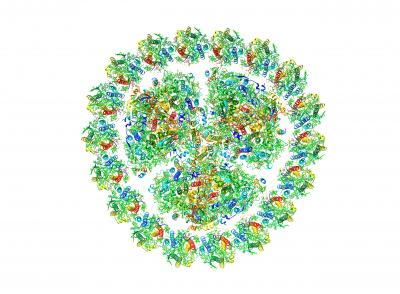Scientists define the role of a cyanobacterial protein in photosynthetic energy transfer process

Credit: 2020 Okayama University
Cyanobacteria, commonly referred to as blue-green algae, are the first organisms on earth that learned to extract electrons from water and convert sunlight to usable energy through photosynthesis. Using cyanobacteria as a model organism, the details of photosynthesis–the key process that supports all forms of advanced lives on earth–have been studied for many decades. And all studies, despite their differences, reveal one thing: that it is an astonishingly precise process, consisting of numerous small reactions run by many proteins and their combinations. However, the molecular-level details of many of these steps are still not understood very well.
The initial energy capture and transmission is one such step that still holds many unanswered questions. At the start of a photosynthetic cycle, special proteins on the membrane of cyanobacteria absorb the solar energy and then transfer this energy to other cellular proteins. This is the “light-harvesting” process. As excess energy can harm the cell, some proteins take part in the dissipation of excess energy, a process known as “energy quenching.” These are closely coordinated processes, with energy transfer between different molecules taking place very quickly, within a few tens of picosecond (1 picosecond = 1 × 10-12 second). In cyanobacteria, two reaction-systems, the Photosystems (PS) I and II, work together to capture the energy from sunlight.
Now, in a new study published in Communications Biology, a team of scientists led by Associate Professor Fusamichi Akita of Okayama University, Japan, has investigated the structure of PSI of the cyanobacterium Thermosynechococcus vulcanus, formed under an iron-deficient condition, to decipher the role of a key protein called iron-stress inducible A protein or “IsiA” in photosynthesis.
In the cyanobacterial membrane, IsiA appears in low iron level conditions, and combines with a trimeric core of PSI to perform the light-harvesting step. Much akin to a runner in a relay race, IsiA “donates” or transfers the captured energy to the trimeric core of PSI that performs the subsequent step in the photosynthesis process. It has been believed that in addition to functioning an “energy harvester,” IsiA also works as a “quencher” that gets rid of excess energy as heat when light intensity is too high for the cells to grow.
Dr Akita explains what made them interested in the IsiA’s function, stating “While IsiA has been considered as both the energy donor and quencher for a long time, the path of these processes is not clear. Moreover, the data accumulated so far suggests a different story, indicating a contrasting possibility that in reality IsiA is involved either in the energy transfer or quenching processes but not in both steps.”
To answer the first question, the team first used a technique called “single-particle cryogenic electron microscopy,” and determined the structure of the “supercomplex” that IsiA forms with the trimeric PSI core and many other molecules in the absence of iron. They found that 18 copies of IsiA come together to form a ring encircling the trimeric PSI core. As a result of this arrangement, several possible energy transfer pathways from IsiA to the PSI core were formed, and a pathway that had the fastest rate of energy transfer was determined to serve as the main route through which the energy moves from IsiA to the PSI core.
To solve the rest of the puzzle as to whether IsiA works as a quencher too, the scientists used a spectroscopic technique called “femtosecond time-resolved fluorescence decay.” The result of this study ruled out the possibility of any energy-quenching taking place in the IsiA-PSI core supercomplex, confirming IsiA’s role as an energy harvester and donor.
Highlighting the significance of this exciting study, Dr Akita states, “These structural and spectroscopic findings provide important insights into the molecular arrangement and energy-transfer mechanisms in the photosystems of cyanobacteria. A deeper understanding of how photosynthetic energy transfer takes place will help to develop new energy devices based on photosynthesis.”
Further studies comparing the inter-species differences in PSI systems are required before we can generalize these findings, but for now, the results of this study have laid to rest a polarizing debate on the function of IsiA.
###
Media Contact
Fusamichi Akita
[email protected]
Related Journal Article
http://dx.




